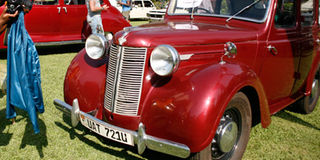‘I don’t share this car’

A car fan takes shots of the Austin 10 at a recent cars show. PHOTOS BY ABUBAKER LUBOWA
What you need to know:
Peji Farooqi likes restoring old cars, including vintages and classics. He works at BHP Motors located in Kibuli.
What is the name of your car?
It is an Austin 10, a British car made in 1932.
How long have you been with it?
I have been with it since 1989.
How have you maintained it?
I import its spare parts from Europe, specifically from London, England.
Where did you buy it from?
I bought it from Kenya in a junkyard where it had been abandoned by the owner.
When do you drive it?
I drive it over the weekends but once in a while.
Have you had any offers?
I have not yet had anyone table an offer to buy it.
Why do you like old cars?
Generally, my family has a history of passion for old cars. Even some of the cars that took me to school are still in my workshop. But I also love keeping old model cars.
Do you ever share it with your friends?
I rarely share with friends but I share it with members of my family. If I am to hire it out for music video shooting, it is done in-house at my workshop or towed to the place where the video is to be shot.
What is its engine size?
It is a 900cc engine.
Is it manual or automatic?
It is a manual car with a side valve water engine. Only lights and the charging system are electronic but the rest of it is manual , including its indicators prop out from the door side.
MORE ON AUSTIN 10
The Austin 10 was produced by the Austin Motor Company. It was launched in 1932 and was Austin’s best-selling car in the 1930s and continued in production, with upgrades, until 1947. It fitted in between their “baby” Austin Seven, which had been introduced in 1922 and their various Austin 12s which had been updated in January 1931.
The design of the car was conservative with a pressed steel body built on a cross braced chassis. The chassis was designed to give a low overall height to the car by dipping down by 2.75 inches (70 mm) between the axles. The 1125-cc four-cylinder side-valve engine producing 21 brake horsepower (16 kW) drove the rear wheels through a four-speed gearbox and open drive shaft to a live rear axle.
Steering was by worm and wheel. Suspension was by half-elliptic springs all round mounted on silent-bloc bushes and damped by frictional shock absorbers. The four-wheel brakes were cable and rod operated by pedal or by hand lever on the offside of the speed lever. The electrical system was 6 volt. For the first year only, a four-door saloon was made in two versions.




